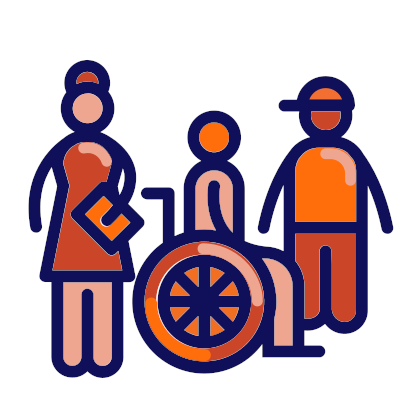Preventing bullying and violence

Schools can, and should, play a key role in tackling these abuses.
Whole-school anti-bullying programmes are needed, which promote peer support systems and involve active and well-trained teachers and parents, to foster a safe learning environment in which no violence is allowed.
Facts & figures
Half of the world’s students aged 13-15 say they have experienced violence in and around school.[1]
Nearly one in three students of this age say they have experienced bullying or been involved in fights.[2]
More than 700 million children have no legal protection from corporal punishment at school.[3]
What is violence and bullying?
Violence is the threatened or actual use of physical force or power resulting in physical or psychological harm to others.
Bullying is a form of violence. It can be defined as unwanted, aggressive behaviour which involves a real or perceived imbalance of power. It is behaviour that is repeated, or carries the threat of being repeated over time.
Bullying takes different forms in school, including:
- Physical, e.g., hitting, kicking, slapping, shoving, hair-pulling, etc.
- Verbal, e.g., name-calling, teasing, using belittling expressions, etc.
- Relational, e.g., ostracising, spreading rumours, social manipulation, etc.
- Sexual, e.g., sexual name-calling, uninvited touching, propositioning, etc.
Cyberbullying is a distinctive form of bullying. It differs from other types on account of the constant risk of public exposure, the complex roles of observers and the size of the audience that comes with digital technologies.[4].
Bullying is not the only form of student-on-student violence in schools, however. Fights between, and attacks on students associated with gang culture and the carrying of weapons, especially knives, are becoming an increasing problem in various countries.
Why is addressing violence and bullying important at school?
Under the U.N. Convention on the Rights of the Child, schools have a formal duty to protect children from all forms of violence, both physical and psychological.
“Parties shall take all appropriate legislative, administrative, social and educational measures to protect the child from all forms of physical or mental violence, injury or abuse, neglect or negligent treatment, maltreatment or exploitation, including sexual abuse, while in the care of parent(s), legal guardian(s) or any other person who has the care of the child.”[5]
Failure to protect children at school can have harmful repercussions on their future lives, both educationally and socially - whether they be victims, perpetrators or bystanders.
Students who are bullied are more likely to suffer from depression and anxiety, health issues, poor academic achievement and behaviour problems at school, including higher drop-out rates. A small number may also retaliate in violent ways. Students who bully others are more likely to exhibit other behaviour problems at school and to suffer from alcohol or drug abuse, and to engage in criminal activity and abusive relationships in adulthood. Children who witness bullying and violence are also more likely to have mental health difficulties and miss or drop out from school.
Violence and bullying not only affects academic learning, it also impacts negatively on the social development of young people. In particular, students who experience violence and bullying are more likely to have difficulty developing basic democratic competences, such as empathy, respect for others, openness to other cultures and beliefs, tolerance of ambiguity and self-efficacy – all of which lie at the heart of the Council of Europe Reference Framework of Competences for Democratic Culture.
The effects of violence and bullying are not limited only to the students directly involved, but potentially impact on everyone at a school. Unchecked, incidents of violence and bullying lead to an atmosphere of anxiety and insecurity incompatible with learning. They also lead to, or exacerbate conflicts beyond the school gates, which in turn have further consequences for relations within the school.
What are the challenges?
Violence and bullying can be challenging to deal with at school. What is regarded as bullying or violence is sometimes thought of as a matter of subjective opinion. It can be difficult to build a common approach to eradicating from school something which a significant proportion of staff believes not to exist or is not important to them.
The prevailing culture in a school can sometimes work against attempts to reduce violence in its different forms. Rule by fear, over-emphasis on punishment and the prioritization of learning environments which support competitive behaviour all militate against the prevention of violence and bullying. So, too, does the holding of an ideology which accepts violence as a valid response in situations of fear, stress or frustration – as evidenced in the advice commonly given to victims of bullying to fight back and give the bully a ‘taste of their own medicine.’
In such circumstances it can be easy to think that dealing with violence and bullying is simply a matter of stopping fights, giving punishments and imposing order, rather than questioning the wider culture of the school, the examples it sets and the sorts of behaviour it supports.
Many teachers are unaware of democratic approaches of dealing with violence and bullying, such as:
- restorative justice
- conflict resolution
- peer mediation.
Such approaches are not only arguably more effective than punitive ones, but also have the advantage of promoting democratic values and attitudes more widely across a school.
Such approaches take time to learn, however, and require the development of specific types of skills, knowledge and attitudes. They also take time to put into practice. It can be difficult for a teacher to find the time and motivation to deal with violence and bullying in a democratic and constructive way. It is easier just to punish the supposed perpetrator, and easier still to pass the perpetrator up the school hierarchy for a more senior member of staff to punish.
A further challenge in recent years has been the rise of gang culture among young people and the carrying of weapons, especially knives, in as well as out of school. This has led to a rise in the number of serious acts of violence between students and also to the more regular involvement of the police in school affairs, both of which demand new professional skills and ways of working from teachers and school leaders.
How can schools get active?
Taking action on violence and bullying is not just a matter of finding better ways of responding to incidents after they have occurred – though this is important, but also of creating the kind of school environment in which violent incidents are less likely to happen in the first place.
A good place to start is with asking students to review the current situation in their school:
- where they feel vulnerable or in danger
- where they feel safe
- what sorts of violence they have witnessed or experienced
- what they see as the causes of these sorts of violence
- how effective they think the school is at dealing with violence
- what further measures they would like the school to take.
Surveying student opinion provides a good evidence base for targeting measures to prevent violence, e.g., increasing supervision in areas in school where students are fearful of going, creating more opportunities for constructive play during breaks from lessons, etc.
It can also stimulate a whole-school conversation about violence and bullying. Such a conversation is important for arriving at a whole-school policy that everyone can support. It is an opportunity to develop a common language and understanding of what constitutes violence and bullying in school and shared rules on how to approach it, including the reporting and monitoring of incidents. This is why it is essential that the voices of all school stakeholders are heard in the process of policy-development: principals, teachers, students, parents and the local community.
The conversation should also include the opportunity for teachers to reflect on practices that lead to frustration and low self-esteem among students, such as an over-emphasis on competition, over-frequent assessment and unreasonably high expectations of academic attainment. Attention should be given instead to creating a school environment which encourages inclusion and co-operation, and the valuing of individual differences and diversity.
Reflection on current practice goes hand in hand with the provision of opportunities for school staff to develop new skills. The ability to recognise violence in all its forms and to be able to deal with it appropriately are important professional skills for any adult involved in school life.
As young people themselves are often the most effective agents for change in a school, it is important they should be involved in formal initiatives to reduce violence and bullying, such as peer mediation schemes. Such schemes are most effective when taken seriously by both staff and the students involved, for example, by instituting formal recruitment procedures for student mediators and opportunities for high-level training from someone with the appropriate professional expertise.
Initiatives of this kind can be supported in the classroom by making time in the curriculum to talk with students about issues of violence and bullying. It should include discussions about the psychology of bullying, the effects of peer pressure and the influence of social media on young people’s behaviour.
[1] UNICEF Report, September 2018
[4] de Morais & Fernandes, 2017. ‘When bullying crossleakes the screen’. In J. Richardson, E. Milovidov & R. Blamire (Eds.), Bullying: Perspectives, Practices and Insights (pp. 11-16). Strasbourg, France: Council of Europe.
 Resources on Preventing violence and bullying
Resources on Preventing violence and bullying
 Related schools projects
Related schools projects
Address: 13 Patmou St., P.C. 55131, Thessaloniki
Country: Greece
Project: A school without walls: Co-creating an open and sustainable learning community
 Working language during the project:
Working language during the project:
- Greek
 Themes of the Council of Europe campaign “FREE to SPEAK, SAFE to LEARN - Democratic Schools for All” covered:
Themes of the Council of Europe campaign “FREE to SPEAK, SAFE to LEARN - Democratic Schools for All” covered:
- Making children’s and students’ voices heard
- Preventing violence and bullying
- Tackling discrimination
 Competences from the Reference Framework of Competences for Democratic Culture (CDC) addressed and where / how they were integrated:
Competences from the Reference Framework of Competences for Democratic Culture (CDC) addressed and where / how they were integrated:
- Value cultural diversity, openness to cultural otherness, respect, listening, critical understanding of the self :
Pupils participated in an oral history project: they collected life stories from their immigrant and refugee schoolmates and family stories of migration and refugee movements from the past. Children made a documentary film by synthesizing different life stories. - Linguistic, communicative, plurilingual skills, cultural empathy, critical understanding:
Pupils made a lexicon of Greek and Arabic common phrases and conversations. - Cooperation, communication, responsibility, flexibility-adaptability, autonomous learning skills, empathy:
Peer groups were created for cooperation and interaction among Greek pupils and pupils of different nationalities. Native pupils took the initiative to familiarise refugee children with school life, its rules, rights and responsibilities. They also listened to their schoolmates' needs.
 Target group age range:
Target group age range:
- 5-11
 Level of education:
Level of education:
- Primary education
Short description of the project:
 Aims/objectives
Aims/objectives
Our project comprised educational activities which aimed to prevent discrimination and to support the inclusion of refugee pupils in our school community.
Specifically, we created peer groups for cooperation and interaction among Greek and pupils of different nationalities. Greek pupils took the initiative to familiarize refugee children with school life, its rules, rights and responsibilities. It is worth mentioning that most of refugee children hadn’t any previous school experience in their own country because of the war.
In addition, we promoted communication and self -expression by the support of a network of mediators, both adults and elder pupils, who knew the languages which the refugee children spoke. Thus, we made refugee children’s voice heard. At the same time, native children found out similarities among the Greek and the Arabic language. A lexicon with basic common phrases was made by pupils.
The daily school programme was enriched with cross-curriculum learning activities which promoted the use of all children's special cultural capital and the developing of different skills. In particular, for our oral history project, children collected family stories which depicted the different past of both refugee and Greek children. Greeks had experience of migration and refugee movements in their history. Pupils’ personal identity proved to be multidimensional. A school archive of tangible and intangible culture was created and the children made a film by synthesizing different life stories.
In addition, we applied cooperative teaching strategies such as action research and team working in projects, which developed the sense of belonging to a community. The participation of children’s relatives and other local society members was encouraged. The learning process at school became more “open”, based on dialogue and the interaction of different aspects. Diversity proved to be an important benefit. Respectively, social prejudices against the “other” were discussed and provoked.
Teachers communicated and reflected critically on their practices and the educational material they could use. Special meetings were organised and as a result the school programme was enriched with subjects and activities promoting values such as equality and justice. Peer evaluation of teachers’ practices was carried out.
In addition, our school regulation was developed based on the values of mutual respect and collaboration.
 Expected results/outcomes
Expected results/outcomes
- Discrimination prevention
- Cooperation, Communication and Critical reflection among teachers, pupils and parents
- Application of innovative teaching strategies such as action research.
- of an archive with life stories and photos of family heirlooms about migration and refugee movements.
- Social skills development.
- Creation of a cooperative school culture
- Making our school open and sustainable.
 Changes
Changes
Mutual respect, openness to cultural otherness, valuing equality, justice and democracy, valuing cultural diversity, development of empathy, linguistic and communicative skills, development of critical thinking, critical understanding of the self and the world.
 Challenges you faced
Challenges you faced
- Preconceptions of students and their parents, based on a “deficit” approach, regarding the abilities of refugee children;
- Low expectations of some colleagues and their lack of knowledge of intercultural education, human rights and citizenship education;
- The knowledge centered curriculum and the lack of time for critical thinking and self-reflection.
 Time-frame of the project:
Time-frame of the project:
A school year - 9 months.
 Council of Europe materials on citizenship and human rights education used while preparing or implementing your practice:
Council of Europe materials on citizenship and human rights education used while preparing or implementing your practice:
- Living democracy-manuals for teachers
- Democratic governance of schools
- All different – all Equal
- Compass
- Compasito
- Mirrors







